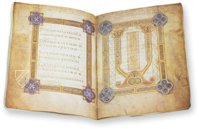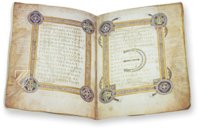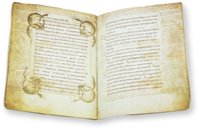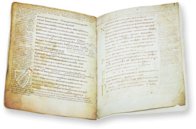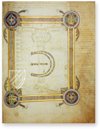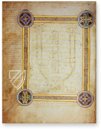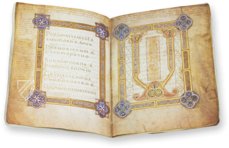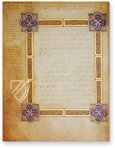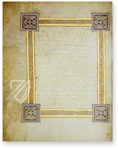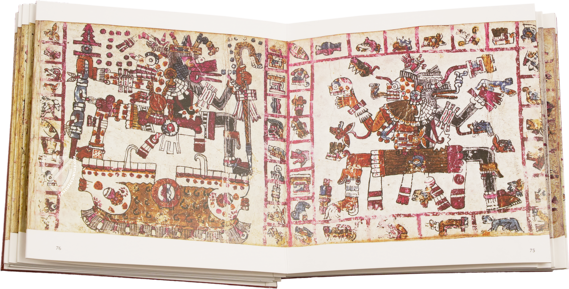Carolingian Sacramentary
(under 1,000€)
Although only representing a fragment of the erstwhile manuscript, the Carolingian Sacramentary belongs among the “gems” of the Austrian National Library. This calligraphic masterpiece was made in the Abbey of Saint-Amand in northern France, and although its original owner remains unknown, it can be assumed from the richness and care of its execution that it was destined for a reputed church or a high dignitary of the church, possibly as a little booklet with prayers and consecration formulas for a bishop’s use. Its rich adornment features a great diversity of calligraphy, accomplished frames and marginal decorations including gold and silver, and a combination of Anglo-Saxon ornamental motifs and Carolingian-Frankish scribal art that is found in very few manuscripts, making this sacramentary an exquisite monument to illumination.
Carolingian Sacramentary
The Carolingian Sacramentary belongs among the “gems” of the Austrian National Library, its priceless manuscripts, as one can see from the addition of the letter C (for Cimelien = gems) in the old signature Theol. C. 992. This calligraphic masterpiece was made in the Abbey of Saint-Amand in northern France. We know very little, however, about the commissioner of the manuscript. The richness and care of its execution make us assume that it was destined for a reputed church or a high dignitary of the church. Numerous remarks and glosses added in the margins and occasionally between the lines indicate that this precious manuscript was frequently used, and conveys a lively picture of the thinking at this period.
A Priceless Jewel for Liturgical Use
The literature frequently calls this manuscript a “sacramentary fragment” as some essential portions are missing. On a small number of pages, our codex contains a wonderfully written text of the Canon Missale and two pages of text for the consecration of a sub-deacon, of which only a few words at the beginning are lost. This might lead to the conclusion that the artistically decorated pages which were later bound in precious gold brocade constituted a little booklet with prayers and consecration formulas for a bishop’s use.
A Masterpiece of Calligraphy
The texts were executed by several hands in different fonts, the Canon being enhanced by the use of gold ink. The text for the consecration of the sub-deacon and a portion of the Canon text are written in a very even Carolingian minuscule, the red headings on fol. 1r-v in capitalis rustica. The major portion of the canon text was written out by a calligrapher in solemn uncials. The numerous remarks and glosses added in the margins and between the lines bear testimony to the great diversity of calligraphy and provide a deep insight into the historical background of the manuscript. Neume annotations used on some pages above the lines guide the user as mnemonic aids through the melody.
The Artistic Adornment
The pages containing the Canon text are surrounded by rectangular ornamental frames the sides of which are filled with intensely entwined interlace making use of different patterns. While the interlace varies from page to page, the corner pieces resemble each other on each double page. A particularly elaborate and imaginative example is found in fol. 5v–6r, where silver bands, seemingly interlaced with the golden borders of the frame, end in animals’ heads whose beaks bite into the golden borders. Two pages hold, in prominent places, only one elaborately stylized word of text (fol. 4r: Vere [dignum et iustum] and fol. 5v: Te [igitur clementissime pater]. The letters are formed of golden borders decorated with elaborate interlace. Fine colorful dots not only line the shafts but also form delicate embroidery on the blank surfaces. This combination of Anglo-Saxon ornamental motifs and Carolingian-Frankish scribal art is found in very few manuscripts and makes this Sacramentary an exquisite monument to illumination.
Codicology
- Alternative Titles
- Karolingisches Sakramentar
Das Karolingische Sakramentar - Size / Format
- 16 pages / 27.8 × 21.5 cm
- Origin
- France
- Date
- Ca. 870
- Epochs
- Style
- Language
- Script
- Carolingian minuscule Rustic capitals Uncial
- Illustrations
- 8 ornamental frames. 2 pages with splendid ornamental writing
- Artist / School
- A splendid blend of Anglo-Saxon décor and Carolingian-Frankish calligraphy
Carolingian Sacramentary
“TE” Initial
Large, elaborate initials were common in Carolingian art, a tradition inherited from the tradition of Insular manuscripts. This manuscript is full of ornamentation influenced by Anglo-Saxon jewelry and metalwork – this dual initial looks like it could be a candle stick or a cross on an altar. Aside from the perfectly-executed interlace patterns, it is noticeable for its animal heads, including a set of four bird’s heads on the tips of the silver “E” with interlocking beaks.

Carolingian Sacramentary
Golden Text Page
This spectacular fragment is a testament to the masterpiece that the original manuscript must have been because the surviving text pages with the Canon of the Mass are all written in gold ink and presented in beautiful frames. The text is written in an unbroken sequence of majuscule letters and was obviously executed by a masterful hand.
This fine, Frankish-style uncial text is surrounded by a frame of silver and gold leaf that is strongly Insular in form and has four bird heads biting into it. The particular form of the interlace patterns are reminiscent of ornamental motifs in Anglo-Saxon jewelry, which was highly coveted. Notes found in the margins are also written so neatly that they could have been part of the original manuscript.

#1 Das Karolingische Sakramentar
Language: German
The scholarly commentary was written by Franz Unterkircher and contains a general introduction as well as a description of the codicological analysis and scripts used for the text. It further describes the decorative apparatus and the contents of the manuscript. The commentary volume is complete with a list of selected literature.
(under 1,000€)
- Treatises / Secular Books
- Apocalypses / Beatus
- Astronomy / Astrology
- Bestiaries
- Bibles / Gospels
- Chronicles / History / Law
- Geography / Maps
- Saints' Lives
- Islam / Oriental
- Judaism / Hebrew
- Single Leaf Collections
- Leonardo da Vinci
- Literature / Poetry
- Liturgical Manuscripts
- Medicine / Botany / Alchemy
- Music
- Mythology / Prophecies
- Psalters
- Other Religious Books
- Games / Hunting
- Private Devotion Books
- Other Genres
- Afghanistan
- Armenia
- Austria
- Belgium
- Colombia
- Croatia
- Cyprus
- Czech Republic
- Denmark
- Egypt
- Ethiopia
- France
- Germany
- Greece
- Hungary
- India
- Iran
- Iraq
- Israel
- Italy
- Japan
- Lebanon
- Luxembourg
- Mexico
- Morocco
- Netherlands
- Palestine
- Peru
- Poland
- Portugal
- Russia
- Serbia
- Spain
- Sri Lanka
- Sweden
- Switzerland
- Syria
- Turkey
- Ukraine
- United Kingdom
- United States
- Uzbekistan
- Aboca Museum
- Ajuntament de Valencia
- Akademie Verlag
- Akademische Druck- u. Verlagsanstalt (ADEVA)
- Aldo Ausilio Editore - Bottega d’Erasmo
- Alecto Historical Editions
- Alkuin Verlag
- Almqvist & Wiksell
- Amilcare Pizzi
- Andreas & Andreas Verlagsbuchhandlung
- Archa 90
- Archiv Verlag
- Archivi Edizioni
- Arnold Verlag
- ARS
- Ars Magna
- ArtCodex
- AyN Ediciones
- Azimuth Editions
- Badenia Verlag
- Bärenreiter-Verlag
- Belser Verlag
- Belser Verlag / WK Wertkontor
- Benziger Verlag
- Bernardinum Wydawnictwo
- BiblioGemma
- Biblioteca Apostolica Vaticana (Vaticanstadt, Vaticanstadt)
- Bibliotheca Palatina Faksimile Verlag
- Bibliotheca Rara
- Boydell & Brewer
- Bramante Edizioni
- Bredius Genootschap
- Brepols Publishers
- British Library
- C. Weckesser
- Caixa Catalunya
- Canesi
- CAPSA, Ars Scriptoria
- Caratzas Brothers, Publishers
- Carus Verlag
- Casamassima Libri
- Chavane Verlag
- Christian Brandstätter Verlag
- Circulo Cientifico
- Club Bibliófilo Versol
- Club du Livre
- CM Editores
- Collegium Graphicum
- Collezione Apocrifa Da Vinci
- Comissão Nacional para as Comemorações dos Descobrimentos Portugueses
- Coron Verlag
- Corvina
- CTHS
- D. S. Brewer
- Damon
- De Agostini/UTET
- De Nederlandsche Boekhandel
- De Schutter
- Deuschle & Stemmle
- Deutscher Verlag für Kunstwissenschaft
- DIAMM
- Droz
- E. Schreiber Graphische Kunstanstalten
- Ediciones Boreal
- Ediciones Grial
- Ediclube
- Edições Inapa
- Edilan
- Editalia
- Edition Deuschle
- Edition Georg Popp
- Edition Leipzig
- Edition Libri Illustri
- Editiones Reales Sitios S. L.
- Éditions de l'Oiseau Lyre
- Editions Medicina Rara
- Editorial Casariego
- Editorial Mintzoa
- Editrice Antenore
- Editrice Velar
- Edizioni Edison
- Egeria, S.L.
- Eikon Editores
- Electa
- Emery Walker Limited
- Enciclopèdia Catalana
- Eos-Verlag
- Ephesus Publishing
- Ernst Battenberg
- Eugrammia Press
- Extraordinary Editions
- Fackelverlag
- Facsimila Art & Edition
- Facsimile Editions Ltd.
- Facsimilia Art & Edition Ebert KG
- Faksimile Verlag
- Feuermann Verlag
- Folger Shakespeare Library
- Franco Cosimo Panini Editore
- Friedrich Wittig Verlag
- Fundación Hullera Vasco-Leonesa
- G. Braziller
- Gabriele Mazzotta Editore
- Gebr. Mann Verlag
- Gesellschaft für graphische Industrie
- Getty Research Institute
- Giovanni Domenico de Rossi
- Giunti Editore
- Graffiti
- Grafica European Center of Fine Arts
- Guido Pressler
- Guillermo Blazquez
- Gustav Kiepenheuer
- H. N. Abrams
- Harrassowitz
- Helikon
- Hendrickson Publishers
- Henning Oppermann
- Herder Verlag
- Hes & De Graaf Publishers
- Hoepli
- Holbein-Verlag
- Hortus Deliciarum
- Houghton Library
- Hugo Schmidt Verlag
- Idion Verlag
- Il Bulino, edizioni d'arte
- ILte
- Imago
- Insel Verlag
- Instituto Nacional de Antropología e Historia
- Istituto dell'Enciclopedia Italiana - Treccani
- Istituto Ellenico di Studi Bizantini e Postbizantini
- Istituto Geografico De Agostini
- Istituto Poligrafico e Zecca dello Stato
- Italarte Art Establishments
- J. Thorbecke
- Jan Thorbecke Verlag
- Johnson Reprint Corporation
- Josef Stocker
- Josef Stocker-Schmid
- Jugoslavija
- Karl W. Hiersemann
- Kasper Straube
- Kaydeda Ediciones
- Kindler Verlag / Coron Verlag
- Kodansha International Ltd.
- Konrad Kölbl Verlag
- Kurt Wolff Verlag
- La Liberia dello Stato
- La Linea Editrice
- La Meta Editore
- Lambert Schneider
- Landeskreditbank Baden-Württemberg
- Leo S. Olschki
- Les Incunables
- Library of Congress
- Libreria Musicale Italiana
- Lichtdruck
- Lito Immagine Editore
- Lumen Artis
- Lund Humphries
- M. Moleiro Editor
- Maison des Sciences de l'homme et de la société de Poitiers
- Manuscriptum
- Martinus Nijhoff
- Maruzen-Yushodo Co. Ltd.
- MASA
- McGraw-Hill
- Militos
- Millennium Liber
- Müller & Schindler
- Nahar and Steimatzky
- National Library of Wales
- Neri Pozza
- Nova Charta
- Oceanum Verlag
- Odeon
- Orbis Mediaevalis
- Orbis Pictus
- Österreichische Staatsdruckerei
- Oxford University Press
- Pageant Books
- Parzellers Buchverlag
- Patrimonio Ediciones
- Pattloch Verlag
- PIAF
- Pieper Verlag
- Plon-Nourrit et cie
- Prestel Verlag
- Princeton University Press
- Prisma Verlag
- Priuli & Verlucca, editori
- Pro Sport Verlag
- Propyläen Verlag
- Pytheas Books
- Quaternio Verlag Luzern
- Reales Sitios
- Recht-Verlag
- Reichert Verlag
- Reichsdruckerei
- Riehn & Reusch
- Roberto Vattori Editore
- Rosenkilde and Bagger
- Roxburghe Club
- Salerno Editrice
- Sarajevo Svjetlost
- Schöck ArtPrint Kft.
- Scolar Press
- Scrinium
- Scripta Maneant
- Scriptorium
- Siloé, arte y bibliofilia
- SISMEL - Edizioni del Galluzzo
- Sociedad Mexicana de Antropología
- Société des Bibliophiles & Iconophiles de Belgique
- Soncin Publishing
- Sorli Ediciones
- Stainer and Bell
- Studer
- Styria Verlag
- Sumptibus Pragopress
- Szegedi Tudomànyegyetem
- Taberna Libraria
- Tarshish Books
- Taschen
- Tempus Libri
- Testimonio Compañía Editorial
- Thames and Hudson
- The Clear Vue Publishing Partnership Limited
- The Facsimile Codex
- The Folio Society
- The Marquess of Normanby
- The Richard III and Yorkist History Trust
- Tip.Le.Co
- TouchArt
- TREC Publishing House
- TRI Publishing Co.
- Trident Editore
- Typis Regiae Officinae Polygraphicae
- Union Verlag Berlin
- Universidad de Granada
- University of California Press
- University of Chicago Press
- Urs Graf
- Vallecchi
- Van Wijnen
- VCH, Acta Humaniora
- VDI Verlag
- VEB Deutscher Verlag für Musik
- Verlag Anton Pustet / Andreas Verlag
- Verlag Bibliophile Drucke Josef Stocker
- Verlag der Münchner Drucke
- Verlag für Regionalgeschichte
- Verlag Styria
- Vicent Garcia Editores
- W. Turnowsky
- Waanders Printers
- Wiener Mechitharisten-Congregation (Wien, Österreich)
- Wissenschaftliche Buchgesellschaft
- Wydawnictwo Dolnoslaskie
- Xuntanza Editorial
- Zakład Narodowy
- Zollikofer AG







